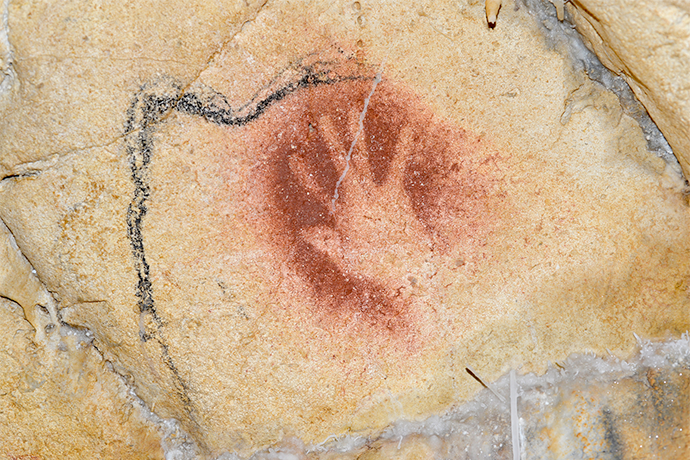Welcome again and thank you for being here. Today I’ve got a mix of STEM links, from kid-friendly science projects (who doesn’t publish them online?) to a cipher Julius Caesar used over two millennia ago. I also have links to something obscure but critical to software development, called CVEs. Plus a look at prehistoric artwork that shows ancient humans paid attention to the animals around them. And what North America looked like 77 million years ago. In the Late Cretaceous period, spell that five times fast. Hope you find these links useful and interesting.
Kid-Friendly Science Projects
During Covid, lots of people had free time to do things. Recently I came across a mention of a YouTuber and their “HOME CHALLENGE: 20 Easy Experiments in 5 mins for Bored Adults and Kids at School Inside.” That’s about 15 seconds per experiment. Sounded fun and it’s linked below.
Digging deeper though, as always, I found tons of kid-friendly science experiments. It’s a thing online. It’s everywhere, from Good Houskeeping to a We Are Teachers site and far beyond. Plus vendors like KiwiCo and CircuitMess, of course. Which makes me think you probably have your own set of links?
So I decided to focus on finding a few fun kid-friendly science projects that amuse me. And on the way maybe point you to a few sites you don’t know about. I try as always to avoid recommending sites with way too many ads.
First, these sites recommend starting kids off with the scientific method. At least a notebook where they can write down details about each experiment. For example, what they think will happen, what happened, and then the reasons for the result. That makes excellent sense. It adds a thoughtful layer to the “let’s get this done” part of any project.
If you have a kid who doesn’t like to brush their teeth, the Good Housekeeping site has a great project. You dip eggs in cola and juice. The control eggs are bare. You slather the test eggs with toothpaste. And leave the test eggs and control eggs soaking overnight. You can guess what happens. Toothpaste on the test eggs reduces the coloration. That’s the Brush, Brush project on the Good Houskeeping site, link below.
Meanwhile, the We Are Teachers site has a dancing popcorn project. It uses baking soda and vinegar. Lots of these science projects use those materials, if you didn’t know. Their projects also include worksheets. But you have to sign up. Or right mouse click the worksheet image to Open Image in New Tab then print the image. Either way, a worksheet is very useful.
PBS Parents also has an interesting take on kid-friendly science projects. They organize projects by the number of ingredients. Plus they offer a few useful guides to encourage and help kids interested to learn about science.
Another common and interesting science project for kids is making ice cream in a bag. Who doesn’t like that idea? I found a few links and recipes below. The challenge is how to avoid too salty ice cream. But figuring that out might wind up being a delicious problem to solve.
And, of course, you could try the Home Challenge, the 20 easy experiments in 5 minutes video. That’s taught by Dianna Cowern, aka PhysicsGirl, a Physics major from MIT. Unfortunately she has long Covid and unable to do videos recently.
45 Easy Science Experiments for Kids
https://www.goodhousekeeping.com/life/parenting/g32176446/science-experiments-for-kids
The Dancing Popcorn Experiment
https://www.weareteachers.com/dancing-popcorn-experiment/
https://www.weareteachers.com/easy-science-experiments/
Simple Science Activities – PBS Parents
https://www.pbs.org/parents/simple-science-activities
Make Ice Cream in a Bag
https://www.sciencebuddies.org/stem-activities/ice-cream-bag
Ice Cream in a Bag
https://www.thebestideasforkids.com/ice-cream-in-a-bag
Homemade Ice Cream in a bag Kids easy DIY Science Experiments
https://www.youtube.com/watch?v=wGbh0uIR_4w
HOME CHALLENGE: 20 Easy Experiments in 5 mins for Bored Adults and Kids at School Inside
https://www.youtube.com/watch?v=8aaXZDazPxs
PhysicsGirl Videos
https://www.youtube.com/channel/UC7DdEm33SyaTDtWYGO2CwdA
The Caesar Cipher
Last week, I wrote about column ciphers. I want to write a few short pieces about different secret codes. Each code is a way to explore history and math. This week, I want to write about Caesar ciphers.
As you might guess, it’s a secret code Julius Caesar used around 58 BC. He used the code to share personal and military messages. He used other cipher techniques, mentioned by Roman writers, but they’re lost to history.
Unlike column ciphers, the Caesar cipher is straightforward. You have your message to encrypt and then replace each letter with another letter. Each letter used to encrypt is 3 letters ahead or behind the letter in your message. You replace the letter C, for example, with the letter F because D E and F are the three letters after C.
Caesar preferred a ROT3 cipher, shorthand for Rotation 3. Three was his magic number. You can pick any number and direction to offset if you’re consistent. ROT13, for example, uses the letters 13 letters ahead or behind a letter in your message. Today, people use ROT13 ciphers to hide information in online forums. For example, spoilers or solutions to puzzles.
Identifying the message language is the hardest part of decrypting Caesar ciphers. Once you know the language, then you figure out the offset. You use either brute force or analysis of the letters in the message.
For example, the letters A, E, O, and T are the most commonly used letters in the English alphabet. J, Q, X, and Z are least used. A message that has lots of the same letter might show that the letter is A, E, O, or T. The GhostVolt article link has a chart that shows letter frequency for English.
Brute force decryption tests all possible shifts for part of the encrypted message. Because the English language has 26 letters, at most there’s only 26 tests needed.
Today, the Caesar cipher is used sometimes with other modern complex ciphers. It’s a way to make one cipher technique more difficult to decrypt. There’s also an interesting way to use math with a Caesar cipher. That’s described in the Wikipedia article.
Caesar Cipher
https://en.wikipedia.org/wiki/Caesar_cipher
The Story of Cryptography
https://ghostvolt.com/articles/cryptography_history.html
Caesar Cipher Encoder and Decoder
https://cryptii.com/pipes/caesar-cipher
What’s a CVE?
As you use software, you might wonder if the software is secure. And wonder, how would you know? Humans being humans, tools like software are prone to failure and insecurity.
CVEs are one method people use to secure their software. CVS is short for Common Vulnerabilities and Exposures. Each CVE has a unique identifier. Each one classifies and describes one security vulnerability in software and/or hardware. They provide a common language people can use to discuss software security flaws. This allows easier communication between people. It helps to reduce risk.
Founded in 1958, the nonprofit MITRE Corporation maintains the list of CVEs. And the US Department of Homeland Security sponsors the MITRE Corporation. CVEs are published on a site called CVE.org.
How this works is interesting. Independent researchers do a mix of testing and research to identify security problems. Finding a problem leads to publishing a CVE. For example, years ago someone discovered cross-site scripting. Hackers figured out how to inject code into web pages, for example, payment pages. The code captured and then sent sensitive user data to the hackers. The cross-site scripting CVE allows software vendors to test and fix this vulnerability.
When companies buy software, often they will test for known CVEs. If the software has a vulnerability, the vendor has to fix the software before sale.
I found out about CVEs while writing software release notes. The tickets used to track fixing a CVE often included only the CVE identifier. I had to look up the identifier and then come up with a short description. Release notes are how software buyers confirm a CVE is addressed. And, if you don’t know, release notes are a document that lists all changes for a release, including any CVEs. People use tickets to manage changes. Each ticket tracks one change. And some tickets track multiple tickets, each with their own change.
What is a CVE?
https://www.redhat.com/en/topics/security/what-is-cve
CVE.org
https://www.cve.org/
https://www.cve.org/ResourcesSupport/FAQs
MITRE
Prehistoric Cave Art
In 2010, I saw a movie called Cave of Forgotten Dreams. It’s about the Chauvet Cave in France with artwork 36000 years old. One hand print, in particular, could identify the artist were they alive today. Their middle fingers were bent closely together. What amazed me is that the cave was open long enough to create the artwork. People also used the cave as a religious site. Then it was lost for tens of thousands of years, as if it never existed.
With prehistoric cave art, people used technologies to describe their world. They knew certain stones could create red, ocher, and other colors. And that charred wood created black. They also studied carefully the world around them. Some medieval manuscripts have poorly drawn horses. However, we can identify animals in most cave art.
In addition to the Chauvet Cave, the Lascaux cave also has amazing art from 17000 years ago. There’s a lot of interesting content online to explore. And I found one video geared toward helping kids engage cave art by creating their own artworks.
Both caves, like all caves, are affected by human contact. Breathing, for example. And carrying in fungus and microbes as we walk around. You can’t visit either cave. But there are replica caves to visit in person. And lots of photos and videos online give you a similar experience. I found the Discovery video on the Chauvet Cave site very moving, showing the cave soon after it was discovered. But it helps to know a little French to fully understand the video.
Lascaux
https://archeologie.culture.gouv.fr/lascaux/en
https://lascaux.fr/en/
https://lascaux-ii.fr/en/
Lascaux – Wikipedia
https://en.wikipedia.org/wiki/Lascaux
World Art for Kids – France’s Caves of Lascaux
Chauvet – Pont d’Arc Cave
https://archeologie.culture.gouv.fr/chauvet/en
First Impressions – The New Yorker
https://www.newyorker.com/magazine/2008/06/23/first-impressions
Cave of Forgotten Dreams
https://en.wikipedia.org/wiki/Cave_of_Forgotten_Dreams
https://www.imdb.com/title/tt1664894/
This Week
Our Sunday email this week will have fun often offbeat links about … Look for the email this Sunday.


